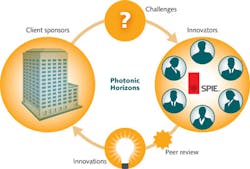MARKET INSIGHTS: Accelerate innovation with an open model for commercialization
"Open innovation" has become a new model for supplementing and accelerating a company's innovation programs. The term was coined in a book by Henry Chesbrough1 in which he described how valuable ideas can come from inside or outside a company, and how these ideas can and should be utilized to go to market either via the company's traditional markets, new markets, or licensed to other companies.
This approach places external ideas and paths to market on the same level of importance as those typically reserved for internal ideas and paths to market. The acceptance and implementation of this approach has increased significantly over the past few years as companies have begun to see and report on the benefits and potential offered by leveraging technology, capabilities, and knowledge from outside the organization's borders.
Implementing an open innovation strategy can result in a bit of a culture shock to an organization, especially if the company has been entrenched with a "not invented here" culture for many years. Even companies that have overcome this culture and are interested in looking outside hesitate to do so as they do not know how or are afraid to work with other noncommercial institutions.
We formed Open Photonics Inc. (OPI) as a photonics-only technology and new product development accelerator. Our team has created an open innovation process that is designed to facilitate collaboration between established companies with channels to market, and researchers and inventors having new ideas that they want to see commercialized. This can be done cost-effectively by leveraging the funds and resources invested in photonics R&D around the world to harvest a great variety of quality products and technology development opportunities.
We believe that by providing a process, oversight, and a framework for companies to collaborate with researchers and innovators, all companies can overcome their hesitation and fear, and gain access to a significantly wider network of talent and technology. We do this in part through a unique grant program.
Photonic Horizons grant program
The OPI Photonic Horizons grant program is a client-funded, two-stage, peer-reviewed R&D funding initiative. In it we leverage experience and lessons learned in operating successful technology transfer and open innovation programs.
To identify new technology ideas for our clients, we conduct an annual solicitation for the program, which is seeded by a list of product and technology areas of interest to our clients. Original ideas in new areas are encouraged, thereby exposing our clients to new technology possibilities.
Initial stage (Phase I) grants are $10,000 for a six-month proof-of-concept project. To apply, applicants put together a three-page (maximum) proposal that describes their invention or product idea, why they think it is needed in the marketplace, and how they're going to develop a proof-of-concept for their idea.
To evaluate these proposals, we have assembled a highly qualified technical advisory board responsible for reviewing the technical merits of the research proposals. We have also established a business advisory board of veteran photonics industry executives, innovators, and investors who provide business and market insight to the submitted ideas.
Grant winners of the Phase I solicitations are chosen by OPI clients with input and guidance from the advisory boards. These innovators can then be invited to apply for second-stage (Phase II) grants of up to $100,000 for a 6–12 month development project to create the first prototypes and facilitate technology transfer.
Intellectual property
To make an open innovation model work, one needs to think very carefully about the treatment of intellectual property. We start the whole interaction with researchers with a unique no-strings-attached open IP policy. This protects both the researcher and the institution-there are no NDAs.
As a result, we require that no proprietary information be shared or disseminated via the application forms. The researcher should share no more information than they would in a scientific publication or talk. This approach allows us to cast a wide net and bring in as many ideas as possible for our clients.
The $10,000 of funding is essentially a gift to the researcher's institution. There are no reporting requirements and the researcher's institution is free to go somewhere else once the Phase I project is done and keep the $10,000. This may be counterintuitive to people familiar with facilitating collaboration between academic organizations and corporations, but if the researcher wishes to move forward and apply for the $100,000 Phase II funding, then they need to submit a final report.
OPI has developed several framework models to use during the Phase II proposal process. Our Phase II application is quite unique as we ask the researcher and their institution to propose their preferred mechanism for licensing and commercialization of the idea, contingent upon second-stage funding. This puts the pressure on the researcher's institution to offer a compelling IP deal and terms to motivate second-stage funding.
Typically, our client who is paying for the grant is offered—at a minimum—a right of first refusal to the IP contingent upon Phase II funding. The IP can then be optioned or licensed if the client desires during or at the end of the second-stage project. Often the clients are not certain if they are interested in commercializing or licensing the technology before the Phase II project is over. This protects both sides from spending tens of thousands of dollars in legal fees before working on the project together. The idea is to spend the money normally going to lawyers with the researchers first.
There is flexibility in our process and projects can be accelerated, funded further, or even acquired directly by our clients. In other cases, Open Photonics may decide to facilitate the launch of a commercial venture in partnership with our clients.
Compared to limited and often short-term internal development efforts or traditional consulting services, OPI provides a much larger number of potential technology and product ideas to choose from, developed in an accelerated timeframe, in an affordable and cost-effective manner.
Our crowd-sourcing and open innovation model brings hundreds of researchers from around the world on board and highlights their work to companies that can commercialize it. Our team then mentors the winners through the process of producing proof-of-concept experiment and functional prototypes.
We believe that a collaborative approach complements and enhances the overall development capabilities for clients. It can quickly and efficiently expand their product lines, often with greater focus, speed, and depth than internal R&D programs could manage alone.
REFERENCE
1. H.W. Chesbrough, Open Innovation: The New Imperative for Creating and Profiting from Technology, Harvard Business Press Books, Prod. #: 8377-HBK-ENG (Apr. 25, 2003).

Jason Eichenholz | CEO of Open Photonics
Jason Eichenholz is the CEO of Open Photonics, which is dedicated to the concept of open innovation—the idea that firms can and should use external ideas in addition to their internal ideas, and internal and external paths to market, to advance the adoption of their technology. Jason was the Photonics Divisional Technology Director at Halma responsible for open innovation, and technology and strategy development for Halma’s Photonics Division. Previously he was CTO of Ocean Optics and Director of Strategic Marketing at Newport/Spectra-Physics.
